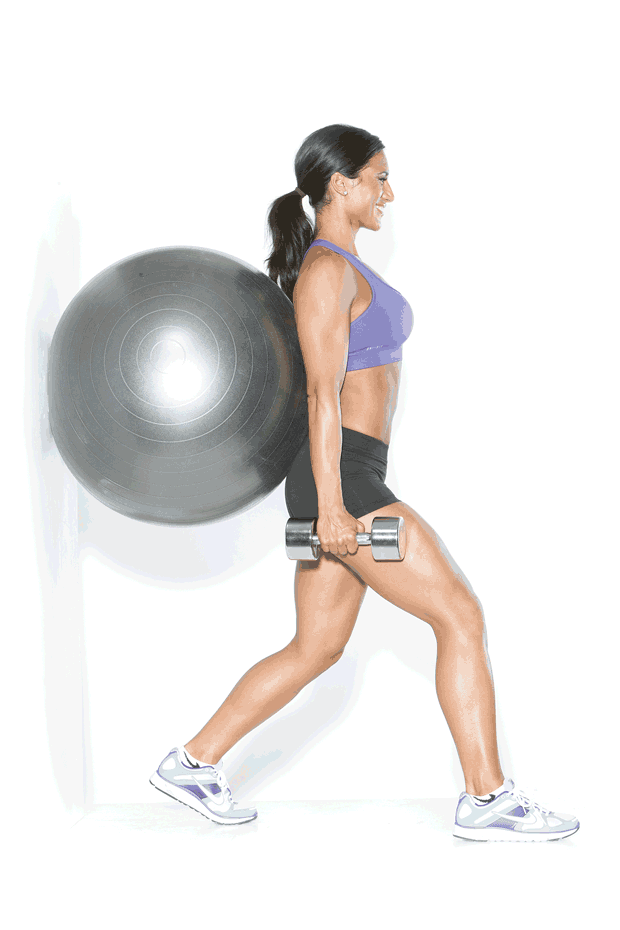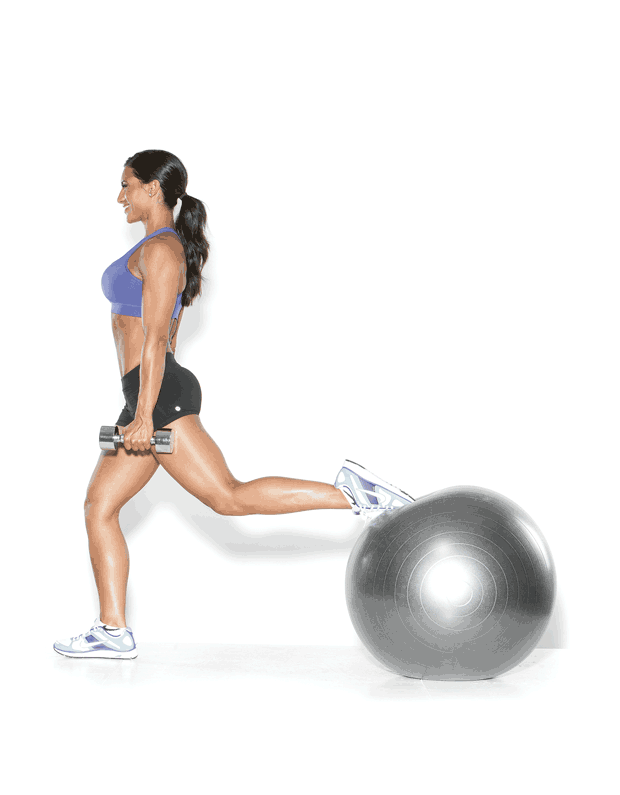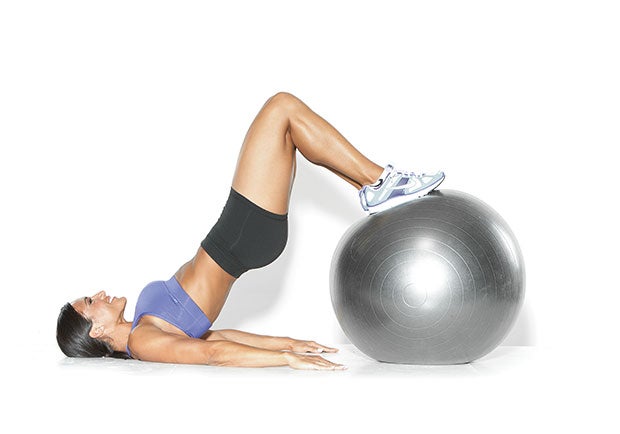Heading out the door? Read this article on the new Outside+ app available now on iOS devices for members! Download the app.
You might not be working toward a guest appearance in Jennifer Lopez’s next “Booty” video — you may simply want to fill out your jeans or turn heads while you’re wearing your bikini this summer. Well, do you have about a quarter of an hour to zero in on your glutes? If so, we have a plan that involves just two common fitness tools: dumbbells and a stability ball. They just may be the keys to shaking up your workouts and getting the rear view you want.
Shock Your Muscles
Bodyweight moves, like squats and lunges, are only effective to a point. Your legs and glutes hold your body up and move it around all day. The traditional upright bodyweight exercises may not be pushing your muscles to the max because your body has adapted to those movements, and that can mean disappointing results for you.
So what is the secret to great glutes? Challenge them! The added weight of dumbbells instantly shocks muscles into working at a higher level, and balancing on a stability ball delivers leverage and intensity that’s hard to achieve by doing the same moves without it.
Adding dumbbells to traditional bodyweight exercises provides multiple benefits. Dumbbells help you develop firmer, rounder glutes by increasing the intensity in moves you love but no longer feel are challenging to you. And in order to see results, you must resist grabbing light weights that you might use for hammer curls or kickbacks. Try using 10- to 15-pound dumbbells to start, or a weight that you can safely lift off the racks and carry comfortably with your arms by your sides.
A stability ball added to your exercise mix will help keep your posture well aligned during standing moves like wall squats and lunges. And incorporating the ball into isolated, floor-based exercises instantly bumps up the intensity while recruiting additional stabilizing muscles in your lower body.
The Wobble Factor
Using a stability ball instantly intensifies your glutes-training efforts because of the ball’s wobble factor. Your gluteus medius, a key stabilizing muscle, becomes more involved when you exercise with “unstable” equipment like the trusty stability ball. The bonus? Using the ball for moves such as wall lunges, leg curls and hip extensions makes stabilizing muscles in the hips, butt and core work harder than they would otherwise. Think about why you do crunches on a stability ball: Just like with your core, the involuntary contractions of your muscles to keep you stable and safe add up to big strength bonuses and a well-balanced butt.
Get Moving
This workout is designed to blast your gluteus maximus and the surrounding gluteal muscles while pulling you out of your butt-training rut. These fresh moves are done with a couple of inexpensive but time-tested fitness tools and will raise your motivation along with your behind. For best results, do this glutes plan two or three times per week using the chart on the previous page, following the prescribed reps, sets and rest periods. Incorporate just the stability ball at first, and once you’ve mastered that, add dumbbells where applicable. Stick to the plan while eating a clean, nutrient-rich diet, and say hello to a firmer behind before swimsuit season is over.
Perfect Posterior Program
| Exercise | Sets | Reps | Rest Between Sets |
| Wall Squat | 2-3 | 12-15 | 30 seconds |
| Wall Lunge | 2 (per leg) | 12-15 | 10 seconds |
| Stability-Ball Split Squat | 2 (per leg) | 12-15 | 10 seconds |
| Stability-Ball Hip Extension | 2-3 | 12-15 | 30 seconds |
| Stability-Ball Leg Curl | 2-3 | 12-15 | 30 seconds |
Wall Squat

Muscles Emphasized: quadriceps, gluteus maximus
How to: With dumbbells in your hands, stand with your feet shoulder-width apart in front of a wall. Position a stability ball between your back and the wall; press against the ball to hold it in place. Grasp a dumbbell in each hand. Bend your knees to go into a squat, rolling the ball along the wall behind you as you descend. Stop when your thighs become parallel to the floor. Keep your knees behind your toes. Hold for one count, then press through your heels to return to standing. Repeat.
Performance Tip: Turn up the heat on your glutes by holding your last rep for 10 seconds.
Wall Lunge

Muscles Emphasized: quadriceps, gluteus maximus
How To: Stand near a wall, holding dumbbells and pressing a stability ball lightly between your back and the wall. Position one foot behind you under the ball, and step the other foot forward. Bend both knees as if you were doing a lunge. Keep your back tight against the ball. Hold, then press through your front heel to return to the start. Complete all reps on one side before switching legs.
Performance Tip: Switch up this move by holding the weights near your collarbone.
Stability-Ball Split Squat

Muscles Emphasized: quadriceps, gluteus maximus
How To: Stand 2 or 3 feet in front of a stability ball, holding a dumbbell in each hand with a neutral grip. Step one foot back and place it on top of the ball, with your sole facing upward. Bend your front leg to lower your body toward the ground. Keep your front knee behind your toes. Pause, then press through your heel to return to standing. Complete all reps on one leg, then switch and repeat.
Performance Tip: As you get better at this move, take a larger step forward — that will really target your glutes.
Stability-Ball Hip Extension

Muscles Emphasized: gluteus maximus, hip flexors, erector spinae
How To: Lie facedown on a stability ball with your core supported. Place your hands on the floor under your shoulders and spread your legs in a shallow V position. Contract your glutes and raise your legs until they are in line with your torso. Pause, then lower back to the starting position without touching your toes to the ground. Repeat.
Performance Tip: Increase the intensity by alternating lifting and lowering each leg.
Stability-Ball Leg Curl

Muscles Emphasized: gluteus maximus, hamstrings
How To: Lie faceup on the floor, resting your calves on a stability ball. Keep your back in contact with the ground, and extend your arms alongside your body, palms touching the floor. Lift your hips by pressing through your palms until your body forms a straight line from your head to your toes. Bend your knees, bringing the ball within inches of your glutes. Hold for one count, then extend your legs without touching your hips to the floor. Repeat from the top.
Performance Tip: Slow the tempo of your reps or make the move unilateral by only using one leg at a time.
Stability-Ball Upkeep
To make your ball last and perform at its best, follow these care tips:
- Wipe the surface of the ball with a damp cloth after every workout and examine it for nicks or signs of wear.
- Deflated balls may be good for football quarterbacks, but not for someone working with a stability ball. It shouldn’t flatten out when you’re on it.
- Avoid overinflating the ball. Most exercise balls expand to 55 or 65 centimeters (approximately 22 to 26 inches). A ball that’s larger than 65 centimeters is meant for someone who is very tall.
- Store your ball indoors — not on balconies or in your car — and keep it away from direct sunlight.
- It goes without saying that you should watch out for sharp objects like table corners that could puncture the ball. Consider purchasing a ball that is labeled burst-proof — that type should deflate slowly if punctured.